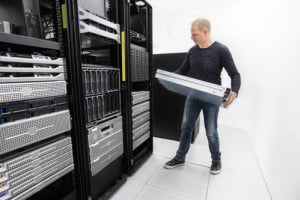
Data center development and operation is expected to grow dramatically in the coming years. But what is driving this need for massive growth?
Data centers are a massive collection of network servers that allow for the storage, processing, and distribution of data and their growth is expected to pick up dramatically in the coming years. But what is driving this need for growth?
Data centers have gone through major advancements as of late, largely due to the progression of IoT. In order for IoT to work effectively, data centers have needed to enhance processing power and utilization of data to increase bandwidth for all of the incoming traffic that IoT creates.
Why Do We Need Data Centers?
With 1.23 billion daily active Facebook users, data is being created, shared and stored at an astonishing rate as more individuals and organizations continue to rely on the internet more than ever before.
Even more remarkable, experts predict that the amount of data is expected to keep rising to reach 44 trillion gigabytes. By this point, researchers project that there will be approximately 30 billion devices connected to the internet, many of which will be able to communicate with other devices through the IoT.
See also: Fog computing meets pint-sized data centers
This might sound surprising at first, but if you take a look at the percentages, you will see that in the United States alone, 70% of consumers binge-watch TV and stream media. Gmail has about a billion active users every month, which is not such a large number in comparison to Facebook, who serves roughly 1.23 billion active users every day.
Studies estimate that 30 billion devices will be connected by 2020. All of that data has to be physically stored somewhere. It is not on your local machine, of course. It is in a data center somewhere, and if the amount of data we use rises, the number of the needed data center will have to grow too.
What’s Driving This Growing Need?
The number of U.S. data centers is now 3 million and growing, which means that over the next 5 years there will need to be an increase of approximately 59% in data scientists positions to maintain data centers and analyze data.
Data scientists will also play a major role in the American and global economies in the coming years by organizing and analyzing data for large companies and government agencies. Businesses have realized how valuable all of this data is, and are using analytics to accomplish strategic business goals. Some companies, like UPS, have invested billions of dollars in big data analytics to become more efficient. Since launching their ORION project (On-Road Integrated Optimization and Navigation) the company has used advanced algorithms and analytics to optimize their drivers’ routes, ensure good driving habits, and cut down on miles and fuel. Reducing the number of miles driven by just one per day for each driver saves the company $50 million a year.
Efficiency isn’t the only reason companies and government agencies are investing in big data, however—they’re also using analytics in a wide range of applications. Large retailers use customer data to find out what makes their customers buy more, and tailor their promotions and new products to meet those needs. Government agencies like police departments use historical crime data to identify crime patterns and take steps to prevent incidents.
In order for these programs to be effective, massive amounts of data are needed. UPS, as one of the first large companies, to really leverage data analytics, stores over 16 petabytes of data. All that data needs to be stored somewhere, and the demand for data centers is rising, not only from consumers but from large companies as well.
Without a doubt, Google is at the forefront of this technology. They have been building their own data centers for a decade. Their experience gave them a chance to develop a network design that has a maximum capacity of 1.13 petabits per second—advances that will become crucial as the amount of data continues to rise.
The Expansion of the Cloud
In this situation, cloud computing technology came as a savior. It was already used in 2016 for data backup, disaster recovery and archiving by 52% of organizations. The biggest advantage of the cloud is the fact it is inexpensive. However, it is also reliable, easily manageable provides measured service, and it opens the door to more efficient data reduction techniques.
Estimates are approximately 92% of data will be processed within cloud data centers by 2020. About 68 % of these will be in public data centers, in comparison to a current situation where the majority of data centers are located in small and middle-sized businesses.
How Are They Impacting the Power Grid?
In data centers industry, power is a major issue as the servers need to be running 24/7. To prevent over-heating, robust cooling systems are an absolute necessity, which further increases the energy costs. US-based server facilities consume about 100 billion kWh a year. That is roughly enough energy to provide the electricity for all households in New York City for two years.
Power savings are not data centers strong suit as 30% of them are functionally dead or using the energy without delivering any useful information. Just eliminating this waste would significantly decrease power consumption.
Overall, look to see the number of data centers increase over the coming years. For individuals that have strong analytical skills, this increase will be great as year over year there will be a growing need for data scientists and analysts. If you plan on looking for a new job over the next few years, don’t wait – get started sharpening analytical skills today!





























